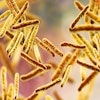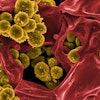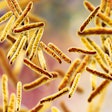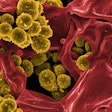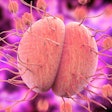
A worrying picture of rising infectious diseases as well as falling childhood vaccination levels and case detection is emerging in Ukraine.
New research, which will be presented at this year’s European Congress of Clinical Microbiology & Infectious Diseases (ECCMID), to be held in Copenhagen from April 15 to April 18, reveals how heavy ongoing fighting in the frontline eastern Kharkiv region has significantly disrupted access to medical care, routine vaccinations, and the response to infectious disease outbreaks.
Researchers analyzed official data from the Centers for Disease Control and Prevention (CDC), in conjunction with the Ukrainian Ministry of Health, to assesses infectious disease incidence and vaccination coverage in the Kharkiv Oblast region between January and September 2022.
They found 124,170 infectious disease cases registered, which was 40% less than during the same period before the war in 2021. Similarly, the proportion of children affected by infectious diseases fell from 29% in 2021 to 23% in 2022. The researchers explained that only severe infections and diseases may have been recorded during this time. Mild cases were not registered or isolated and likely continued exacerbating the spread of diseases, they said.
However, new cases of shigellosis, a highly contagious diarrheal disease, were found to be three times higher in the Kharkiv region than rates across Ukraine. Similarly, new cases of rubella were 11 times higher than the Ukraine average, whooping cough five times higher, and viral meningitis two times higher. Additionally, new cases of viral hepatitis A exceeded the country average by 2.4%, viral hepatitis B by 87%, and chronic viral hepatitis B and C combined by 72%. The high incidence of highly contagious infectious diseases in the Kharkiv region reflects living conditions where widespread infrastructure damage and water and food supply interruptions are common.
The analysis also found that the war has had dramatic effects on routine childhood vaccination rates. Between January and September 2022, the rate of polio vaccination fell to 40%; hepatitis B to just 37%; tuberculosis to 43%; measles, mumps, and rubella to 50%; diphtheria, whooping cough, and tetanus to 46%. The data raise concerns that the upsurge in such vaccine-preventable infectious diseases could soon spiral out of control.
Further analyses within Kharkiv Hospital revealed that the infectious-disease case detection rate is only half of that prior to the war. The hospital, in the capital city, provides medical care to almost 17,000 adults. Between January and October 2021, 2,306 cases were registered; this declined to 1,056 reports during the same period in 2022, suggesting that these figures are most likely an underestimate of the true situation.
“Our findings underscore the urgent need to strengthen medical support in the regions of Ukraine where active hostilities are taking place,” Maryna Railian of Kharkiv National Medical University said in a statement. “We must prioritize field vaccination teams in populated areas and health education campaigns to highlight the growing threats of infectious diseases.”


